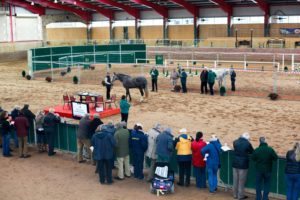Breeding Policy
Horse Sport Ireland is Approved by the Department of Agriculture, Food and the Marine to maintain the Irish Sport Horse Studbook and the Irish Draught Horse Studbook. The HSI Breeding Sub Board is responsible for formulating breeding policies for these studbooks.
In addition, HSI issues identification documents on behalf of a number of other bodies approved to maintain studbooks (eg. Irish Pony Society, Kerry Bog Pony Society) and identification documents for horses with no breeding or partial breeding recorded.
Breeding Goals
Irish Sport Horse Studbook Breeding Objective: To produce a performance horse that is sound, athletic with good paces and suitable temperament and capable of winning at the highest international level in FEI disciplines.
Irish Draught Horse Studbook Breeding Objective: To breed Irish Draught Horses with conformation, movement and temperament that conform to the breed standard, which will make good quality, sound and versatile horses.
Main Elements of HSI’s Breeding Programme for Irish Sport Horses and Irish Draught Horses:
1. Registration
The bedrock of any breeding programme is ensuring that all pedigree information is recorded and verified. Between 15 and 20% of foals are still registered each year without full breeding recorded.
In order to encourage breeders to fully record pedigree the cost of registration has been kept to a minimum. This price includes microchips, which are provided to veterinary surgeons free of charge for use in HSI registered horses, and the cost of verifying pedigree information through DNA analysis.
2. Studbook Inspections/Classification
Irish Sport Horse and Irish Draught Horse Studbook inspections are carried out annually in order to identify quality stallion and mares that adhere to the studbook breeding goals.
· Stallion Inspections
 Stallion inspections take place in February/March each year and are open to the public. A new inspection process was introduced in 2010 which features trained inspectors and arena party, an enhanced loose jumping element, linear scoring, a detailed stallion catalogue incorporating pedigree and performance information, public announcement of provisional results and a comment from the Chairman of the inspection panel on each stallion. Stallions are assessed on the basis of their pedigree, conformation, movement and athleticism. Irish Draught stallions are also assessed on their adherence to breed type. All stallions undergo a rigorous veterinary examination, including X-Rays, in order to identify undesirable conditions.
Stallion inspections take place in February/March each year and are open to the public. A new inspection process was introduced in 2010 which features trained inspectors and arena party, an enhanced loose jumping element, linear scoring, a detailed stallion catalogue incorporating pedigree and performance information, public announcement of provisional results and a comment from the Chairman of the inspection panel on each stallion. Stallions are assessed on the basis of their pedigree, conformation, movement and athleticism. Irish Draught stallions are also assessed on their adherence to breed type. All stallions undergo a rigorous veterinary examination, including X-Rays, in order to identify undesirable conditions.
Linear profiling is used to assess conformation, movement and athleticism. This is a descriptive method of assessing a horse and describes where a horse lies between the biological extremes for any given trait. Following inspection a linear profile is produced for each stallion which outlines the stallion’s strengths and weaknesses. This information is published in the stallion book and is especially useful for mare owners as it provides them with a detailed description of potential stallions they may wish to use in their own breeding programmes.
· Mare Inspections
Mare inspections for the Irish Sport Horse and Irish Draught Horse studbook are held at regional centres throughout the country in spring and autumn. Mares are assessed on their conformation and movement and undergo a veterinary examination. Irish Draught mares are also assessed on their adherence to breed type. Mare owners have the opportunity to loose jump their mares for an athleticism assessment.
Breeders that present their mares for inspection are provided with a linear profile for their mare. From the linear profile mare owners can identify areas where their mare may be lacking in conformation, movement and athleticism. This is essential information for any mare owner wishing to identify stallions that compliment their mares attributes and to decide which market/discipline future offspring would be most suited to.
· Classification
Following inspection horses are classified in different classes depending on the outcome of the inspection. Breeders can be assured that stallions that are classified as ‘Approved’ have meet all of the performance/inspection and veterinary requirements for the Irish Sport Horse Studbook. Similarly, stallions that meet all of the inspection and veterinary requirements for the Irish Draught Horse Studbook are classified as ‘Class 1’.
Mares that meet inspection and veterinary requirements are also eligible for higher classifications within the Irish Sport Horse and the Irish Draught Studbooks. This higher classification adds value to the mare and her offspring.
3. Information for Breeders
At the core of the HSI breeding policy is providing breeders with the maximum amount of information and resources to make the best possible breeding decisions for their own mare herd. HSI publish a number of publications for breeders. These include the Stallion Book, Foal Book and the HSI Breeder Magazine.
· Stallion Book
The stallion book is published every second year and is a vital source of information on available Approved/Class 1 stallions. Information relating to pedigree, merits, performance and progeny performance from FEI, Showjumping Ireland, Eventing Ireland and Dressage Ireland competitions are published for each stallion. Stallion pictures are provided where available.
· Foal Book
The foal book is published annually and provides breeders with information on all foals registered in the Irish Sport Horse and Irish Draught Horse Studbooks within a given year.
· HSI Breeders Magazine
The HSI Breeders Magazine is published twice a year and contains articles and features of interest to breeders. The publication covers a wide range of topics including Irish Sport Horse and Irish Draught Horse studbook achievements, equine health, market requirements, breeder features, and information on inspections and breeding policy.
Other sources of information provided to breeders include ‘CapallOir’, Additional Merits and Genetic Evaluation results.
· CapallOir
‘CapallOir’ (available at www.horsesportireland.ie) is HSI’s online database which links pedigree information with performance information from the FEI, Showjumping Ireland, Eventing Ireland and AIRC. This resource has proven to be extremely useful for breeders when choosing stallions to cover their mares and in sourcing information on horses they wish to buy or sell.
· Additional Merits
A star rating system was introduced in 2010 for stallions classified as ‘Approved’ and mares classified as ‘Select’ in the Irish Sport Horse Studbook. Star ratings range from 1 to 5 stars and are awarded on the basis of performance, damline and progeny performance in showjumping, eventing and dressage. For mare owners these accolades add significant value to their mares and their offspring. They also allow mare owner to easily decipher which stallions have performed at the highest level and which stallions are producing successful offspring in showjumping, eventing etc.
Additional merits (Bronze, Silver and Gold) are awarded to horses classified in ‘Class 1’ of the Irish Draught Horse Studbook. Irish Draught merits are also awarded on the basis of performance, damline and progeny performance and cover a range of disciplines, including showing.
· Genetic Evaluation
HSI carries out a genetic evaluation for showjumping horses in Ireland in order to identify horses with high genetic merit, or Breeding Value, for showjumping ability. Breeding Values for showjumping ability are based on performance, and the performance of relatives, in national SJI competitions and performances at international level.
4. Conservation and Research
The Irish Draught Horse is classified as an endangered breed and a number of initiates are in place which are aimed at conserving the genetic diversity of the breed. Genetic diversity measures are calculated for stallions and mares that are presented for inspection and horses that meet specified criteria are awarded pedigree bonus points aimed at helping horses that are valuable from a genetic diversity point of view to meet inspection requirements. Information relating to genetic diversity measures for Irish Draught Horses are published on CapallOir including relationship coefficients with the Irish, Australian and Canadian Irish Draught mare herds and relationships with the most prevalent ancestors (ie. King of Diamonds, Ben Purple and Pride of Shaunlara). Information on Irish Draught stallions standing abroad that are classified in the Irish studbook are also provided on CapallOir and in the stallion book in order to widen the pool of available stallions for breeders in Ireland.
HSI is involved in research projects on an ongoing basis relating to breeding, conservation and the sport horse industry/market.
5. Sponsorship
The HSI sponsorship programme is largely focused on supporting classes that are restricted to horses with recorded pedigree, encouraging excellence and supporting Irish owners and breeders. Substantial prize money is provided each year to the Irish Sport Horse Showjumping Series, Tattersalls Three Day Event, the RDS, the Clifden Connemara Pony Show and the Irish Shows Associations Championships, as well as other equestrian events throughout the country.
HSI also provides funding and support each year for horses representing the Irish Sport Horse Studbook at the FEI World Breeding Championships for Young Horses, Lanaken, Belgium and the WBFSH World Championships for Young Event Horses, Le Lion d’Angers, France. These are very prestigious events which receive substantial media coverage and considerable international recognition amongst breeders and owners. Participation and success at events such as these are important for marketing Irish horses and attracting owners and buyers to Ireland.
6. Promotion
HSI monitors the performance of Irish Sport Horses and Irish Draught Horses in international competitions and publishes the results on an ongoing basis on the HSI website. Irish horses are promoted through trade stand exhibits at equestrian shows and through advertising in international equestrian publications.
The sale of Irish horses is supported through the Inward Buyer Programme, which offers refund on travel fairs for individuals from abroad that purchase Irish horse(s) at selected sales and shows. Performance sales, such as the Going for Gold sale, are also supported by HSI.
7. Young Breeders
The ISH Young Breeders programme is a joint programme run by Horse Sport Ireland and Teagasc. The programme is aimed at those aged between 14 and 25 years who are interested in assessing, exhibiting, and breeding performance horses. The Young Breeders Programme provides training to young people, imparting them with the skills to assess horses which will benefit them when purchasing a new horse, making breeding decisions, assessing offspring and presenting horses for inspection, sale, show or competition.
A National Young Breeders competition is organised each year and competitors are asked to complete a theory examination, present a horse in hand and assess conformation, loose movement and loose jumping. Young Breeders that excel in National competitions and training events are selected to represent the Irish Sport Horse Studbook at the World Championships which are held overseas every two years.
8. Studbook Rules
Click here to download the Rules and Practices Relating to the Irish Horse Register


















